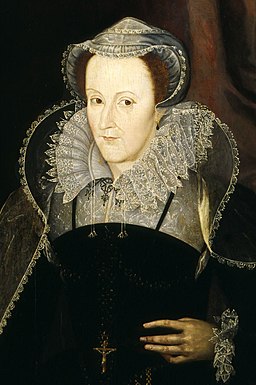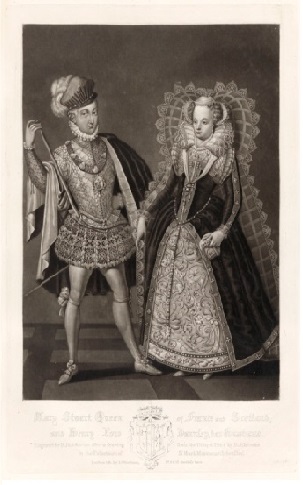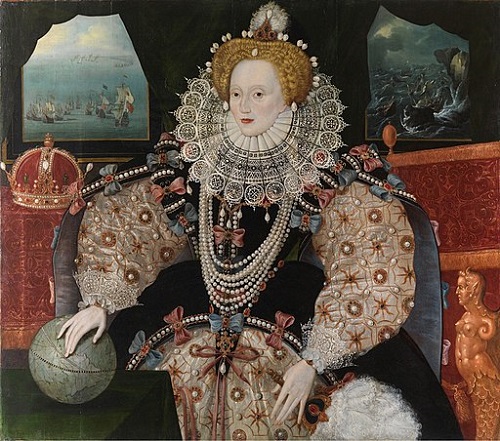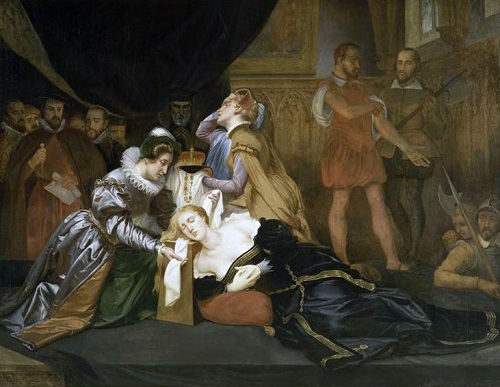Mary Queen of Scots
The line of Stewart monarchs of Scotland began in 1371, descending from the union of Marjorie, daughter of King Robert the Bruce, and Walter, the 6th High Steward of Scotland. Mary, Queen of Scotts was born in Linlithgow Palace, Scotland on December 8, 1542, and just a few days later her father, King James V, died and she became infant Queen of Scotland when she was just six days old.[1]
Mary was sent to live in France as a child, and by the time she returned to Scotland, she was spelling her name ‘Stuart’ in the French fashion. In 1558, when she was just 16 years old, she married Francis, Dauphin of France, therefore making her queen consort of France. Francis died in 1560, at which point Mary returned to Scotland and in 1565 she married her half-cousin, Henry Stuart, Lord Darnley. After just two years of marriage, Lord Darnley was murdered, leaving Mary as a widower once again.[1]
James Hepburn, 4th Earl of Bothwell, was thought to be responsible for Lord Darnley's death;[4] however, he was released after a 72-hour trial and in 1567 he became Mary's third and final husband. The public greatly opposed the marriage and Mary was imprisoned at Lochleven Castle for eleven months before fleeing to England to seek help from her cousin, Queen Elizabeth I. [1]
Elizabeth I felt threatened by Mary's arrival in England and Mary was once again imprisoned, but this time it lasted for nearly 19 years. While Mary was imprisoned she was found guilty of plotting to have Queen Elizabeth I assassinated. [6] Some historians believe that Mary was set up and that she never actually wrote the letters about her cousin's assassination. Regardless, Elizabeth I charged her with treason and she was sentenced to death.[1]
Mary was beheaded on February 8, 1587, at the age of 44. Her execution took place in the Great Hall of Fotheringhay Castle in Northamptonshire, England. It is recorded that her final words were "In manus tuas, Domine, commendo spiritum meum", which translates to "Into thy hands, O Lord, I commend my spirit." [4] She has remained one of history’s best known figures for her legendary beauty, her strong character (she was the Catholic Queen of a nation in the throes of the Protestant Reformation), and her untimely execution.
References
- ^ Fraser, Antonia. Mary Queen of Scots. Weidenfeld and Nicolson. 1994.
- ^ "File:Mary, Queen of Scots after Nicholas Hilliard (crop).jpg." Wikimedia Commons, the free media repository. 18 Aug 2016, 20:30 UTC. https://commons.wikimedia.org/w/index.php?title=File:Mary,_Queen_of_Scots_after_Nicholas_Hilliard_(crop).jpg&oldid=204241379
- ^ "File:Henry Stuart, Lord Darnley; Mary, Queen of Scots, by Robert Dunkarton, published by Samuel Woodburn, after Renold Elstrack.png." Wikimedia Commons, the free media repository. 7 Apr 2020, 18:30 UTC. https://commons.wikimedia.org/w/index.php?title=File:Henry_Stuart,_Lord_Darnley;_Mary,_Queen_of_Scots,_by_Robert_Dunkarton,_published_by_Samuel_Woodburn,_after_Renold_Elstrack.png&oldid=409704557
- ^ Guy, John. "My Heart is my Own": The Life of Mary Queen of Scots. London, England: Fourth Estate.
- ^ "File:Armada Portrait Elizabeth I Queens House.jpg." Wikimedia Commons, the free media repository. 18 Nov 2019, 00:30 UTC. https://commons.wikimedia.org/w/index.php?title=File:Armada_Portrait_Elizabeth_I_Queens_House.jpg&oldid=376078786
- ^ Somerset, Anne. Elizabeth I. Penguin Random House. 1991.
- ^ "File:Execution-of-Mary-Queen-of-Scots.jpg." Wikimedia Commons, the free media repository. 21 Dec 2017, 22:35 UTC. https://commons.wikimedia.org/w/index.php?title=File:Execution-of-Mary-Queen-of-Scots.jpg&oldid=273503133
- ^ Swyrich, Archive materials



